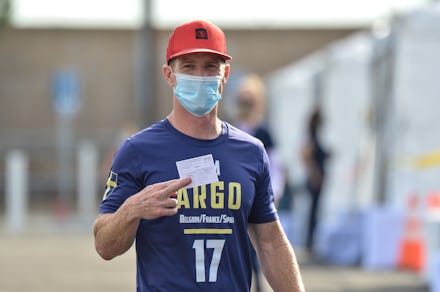Fully vaccinated? Here's what you're now allowed to do, you lucky bastard

For many of us, time spent with friends and family ranks among the losses we’ve grieved the most during the pandemic. Now, new guidelines that the Centers for Disease Control and Prevention released on Monday say that people fully vaccinated against COVID-19 can start reuniting with some loved ones, CNN reports. They can safely gather with each other and small groups of unvaccinated people under certain conditions.
Who counts as “fully vaccinated?” Those for whom two weeks have passed since their single dose of the Johnson & Johnson vaccine, CNN explains, or their second dose of the Moderna or Pfizer-BioNTech vaccine. The CDC estimates that about 10% of people in the U.S. are fully vaccinated, STAT reports, a figure expected to rise sharply thanks to the country’s vaccination campaign.
The vaccine offers protection, but it’s not entirely clear for how long, according to CNN. Evidence increasingly suggests that it also prevents the transmission of COVID-19. Recent data from Israel demonstrates that Pfizer-BioNTech’s vaccine is highly effective at curbing spread, per STAT.
These lingering unknowns, as well as the fact that most of us remain unvaccinated at the moment, means that while vaccinated people can start spending time with people the way they used to, at least to some extent, they still need to proceed with caution. Here are the main takeaways from the new CDC guidelines about what activities they can resume right now:
They can spend time indoors with each other and with certain unvaccinated people
Fully vaccinated people can hang out with other vaccinated people indoors sans masks or physical distancing, according to CNN. They can also skip masks and physical distancing when hanging out indoors with unvaccinated people from the same household who are at low risk for severe disease.
They still need to take care to minimize risk to themselves and unvaccinated people
If they’ve been exposed to someone with asymptomatic disease, they no longer have to quarantine or get tested, according to CNN, but still need to stay on the lookout for any symptoms for two weeks. They should also still mask up and physically distance from unvaccinated people who are from different households, at higher risk for severe disease, or live with a high-risk individual. Basically, the precautions taken should be dictated by the needs of the unvaccinated people, who remain susceptible to COVID-19.
The basic precautions still apply
That includes wearing a mask that fits properly and physically distancing in public, washing hands often, and steering clear of medium- to large-sized crowds, per CNN. Amid the high case counts, vaccinated and unvaccinated people alike should continue to avoid travel for now.
And while the risk of infection for vaccinated people in settings like restaurants and gyms is lower, CNN notes, it’s not zero. These places have a higher risk of transmission, which increases the greater the number of unvaccinated people present.
Yes, we need to take care to avoid what STAT refers to as “vaccine euphoria,” or the tendency to ditch precautions as we get swept up in optimistic vaccine headlines. But for those of us millennials and Gen Z-ers whose parents and other older loved ones are getting vaccinated — many of whom we haven’t seen in a long time — the new CDC guidelines are a win worth celebrating.